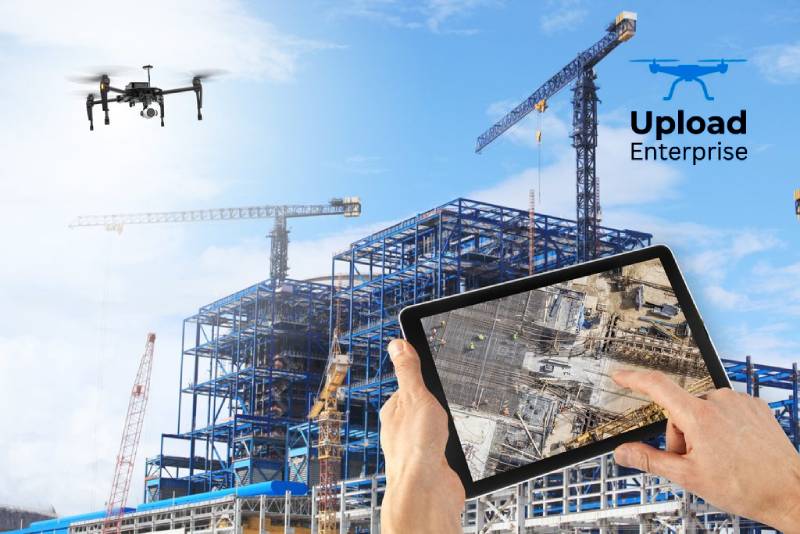As a drone provider for photography and videography services in Sydney, Upload Enterprise must understand the value of frames per second (FPS) in capturing high-quality aerial footage. FPS is an essential aspect of video that directly impacts the smoothness, clarity, and visual attraction of your drone videos. In this blog post, we’ll explore what FPS is, why it matters for drone videography, and how to optimize your settings for the best results.
What is FPS?

FPS can refer to the number of particular images (frames) that can be displayed in a single second of video. The higher fps can give smoother motion to appear on the screen. The rate of FPS is 24, 30, 60, and even 120 frames per second.
The drone videography of FPS is particularly important as drones usually capture fast-moving scenes or track moving subjects. Higher FPS sure that the motion is recorded smoothly, reducing blur and providing a more attractive viewing experience.
FPS is most important for Drone Videography

Smooth Motion: Higher FPS rates like 60 or 120 frames per second. The result will be silky-smooth video, particularly when you capture fast-moving subjects or panning shots. This level of smoothness is necessary for making cinematic, professional-looking drone footage.
Reduced Motion Blur: When you have to shoot at lower FPS, fast-moving objects can seem blurry due to the camera’s shutter speed. Today, with increased FPS you can minimize motion blur and capture crisp, clear footage, even in high-speed situations.
Versatility in Post-Production: You should have to shoot your video or photos at a higher FPS which can make more flexibility in post-production. You have to slow down the footage to create slow-motion effects or post this video to different frame rates for various platforms and devices.
Improved Image Quality: Higher FPS rates are related to higher image quality, as the latest cameras and most drones are designed. These can capture attractive 4K or even 8K resolution footage at high frame rates. This level can provide the details as well as clarity is important for creating visually amazing drone videos.
Competitive Advantage: In the world of drone videography that can provide high-quality, high-FPS footage can provide a competitive edge. Clients will appreciate the smooth, cinematic videos that can help you stand out in the market and attract more business.
Optimizing FPS Settings for Drone Videography

When you set the fps setting up your drone for videography it would be important to consider the FPS rate that can make to be the best suits your needs. Some guidelines help you to choose the right FPS settings:
Determine the Purpose of Your Video: You can consider the type of footage that you have been capturing which can provide the desired look and feel. For example, if you are shooting in a fast-paced action sequence, a higher FPS like 120 frames per second would be ideal. For a more cinematic, film look, a lower rate like 24 or 30 FPS would be preferable.
Consider the Lighting Conditions: In the situation of the low light. You must adjust the need of FPS to maintain a proper shutter speed and avoid underexposure. You need to consult your drones with a manual or experiment with different settings. It can find the best balance between FPS and image quality.
Check Your Drone’s Capabilities: The variety of drones can vary with maximum FPS rates which depend on their resolution and sensor capabilities. You have to be sure that your drone can shoot at the desired FPS for your project.
Test and Experiment: Before starting the shoot you have to take some test footage at different FPS rates and review the results. These can help you to determine the optimal settings for your specific needs and priorities.
Shoot at the Highest FPS Possible: When doubt has to be then you have to shoot generally for the highest FPS that your drone can handle. This can make for flexibility in post-production and provides that you capture the smoothest possible footage.
Incorporating FPS into Your Drone Videography Workflow

There is the most out of your drone videography, it’s necessary to incorporate FPS considerations into your overall workflow. Here are some tips:
Plan Your Shots: First, you have to storyboard and plan your drone video which is the factor in the FPS settings needed for each shot. These can help you anticipate the potential challenges and provide a smooth production process.
Communicate with Your Team: when you are working with the team. You make sure that everyone is on the same page regarding FPS settings. This contains the drone pilot, camera operator, and anyone involved in post-production.
Monitor and Adjust: When ready to capture the shoot keep your eye on the FPS settings and be prepared to make adjustments as needed. This can involve changing the shutter speed, ISO, or other camera settings to maintain image quality.
Optimize for Post-Production: When you are editing your drone footage you will be considering the final output format and frame rate. When you plan to slow down footage for a slow-motion effect you can make sure to shoot at a high enough FPS to maintain the quality of videos.
Stay Up-to-Date with Industry Trends: Drone technology continues to grow and keep an eye on the latest advancements in FPS capabilities. This will help you stay competitive market and confirm that your drone videography remains cutting-edge.
Conclusion
Frames per second (FPS) is a required factor for creating high-quality photos, and professional-looking drone videography. They must understand the importance of FPS and optimize your settings accordingly so that you can capture smooth, cinematic footage that will impress your clients and stand out in the market.
As a drone provider of photography and videography services in Sydney, Upload Enterprise should prioritize FPS as a key aspect of their service offerings, providing that they deliver the best possible results for their clients.